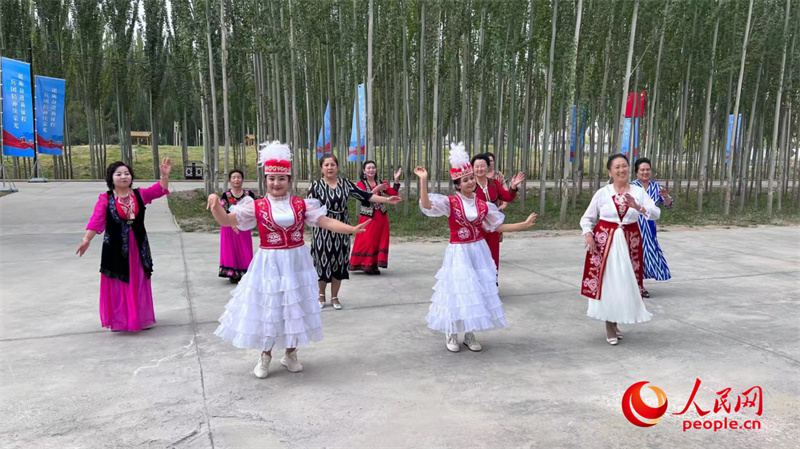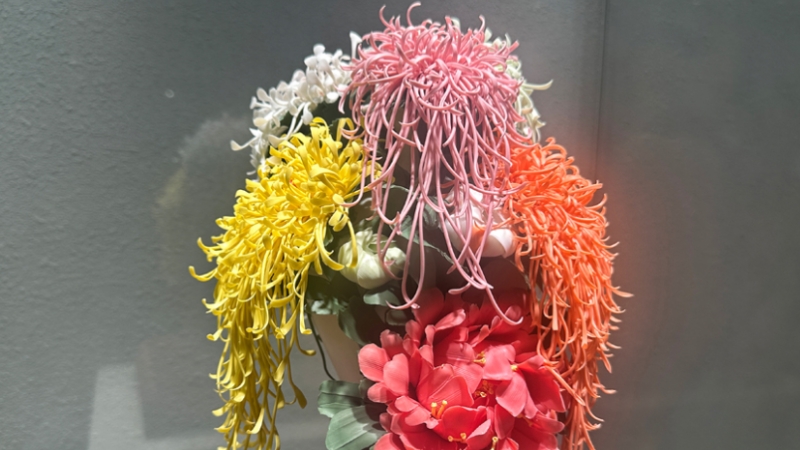Embroidery cooperative dedicated to inheritance of Kirgiz embroidery in NW China's Xinjiang
In a bungalow at the Tuoyun Ranch in the Third Division of the Xinjiang Production and Construction Corps, northwest China's Xinjiang Uygur Autonomous Region, 35-year-old Tanayiguli Juliduoxi sits cross-legged on a colorful wool carpet, showcasing her embroidery skills. As her needle and thread dance through the air, a lifelike butterfly quickly takes shape.

Tanayiguli Juliduoxi (first from right), works on a piece of embroidery. (People's Daily Online/Li Haoyang)
Tanayiguli Juliduoxi is a member of a local embroidery cooperative made up of over 50 skilled embroiderers. Most of them are ranch workers who use their spare time to create exquisite embroidered clothing, felt hats, tapestries, and other embroidered products.
Ethnic Kirgiz embroidery features themes including the sun, moon, stars, flowers, plants, birds, and animals. The colors are vibrant, and the designs are beautiful. In June 2008, Kirgiz embroidery was included in the second batch of the national intangible cultural heritage list.

Photo shows embroidered works on display at an embroidery cooperative at the Tuoyun Ranch in the Third Division of the Xinjiang Production and Construction Corps, northwest China's Xinjiang Uygur Autonomous Region. (People's Daily Online/Li Haoyang)
"Kirgiz women are skilled in embroidery, and for us, embroidery is essential in daily home decorations, festival costumes, and wedding supplies," said Tukong Share, head of the embroidery cooperative. Influenced by her mother, Tukong Share developed a love for embroidery at a young age and started using a needle to embroider at the age of five.

People dressed in traditional costumes dance. (People's Daily Online/Li Haoyang)
In 2000, Tukong Share opened a small embroidery shop with an area of over 20 square meters. Later, many women expressed their eagerness to participate. Recognizing that there was demand, Tukong Share opened an embroidery cooperative in 2015.
In 2019, an embroidery base covering an area of about 517 square meters was built at the Tuoyun Ranch. This base now serves as the workshop for Tukong Share's cooperative. Presently, the cooperative boasts a membership of 60 individuals, including 43 skilled embroiderers. Each member has seen an average annual increase in income exceeding 6,000 yuan (about $842.26).

Photo shows automatic multi-head computerized embroidery machines at Tukong Share's embroidery base. (People's Daily Online/Li Haoyang)
According to Tukong Share, the cooperative mainly sells its products through retail, working with clothing stores, and orders from schools.
"We hope that in the future, we can use the internet to let more people know about the Tuoyun Ranch and Kirgiz embroidery," Tukong Share said.
Photos
Related Stories
- Hard-of-hearing embroiderer from NW China's Xinjiang wins global recognition
- Trending in China | Reviving the craft of making hand-embroidered cuju balls
- Pic story of inheritor of Miao embroidery in Guizhou
- Yi Embroiderers in SW China Demonstrate Traditional Embroidery Skills
- Embroidery of Yi ethnic group performed during Milan Fashion Week
- China's Miao embroidery shows at Milan Fashion Week
- Miao embroiderer takes ethnic intangible heritage to world stage
Copyright © 2023 People's Daily Online. All Rights Reserved.









